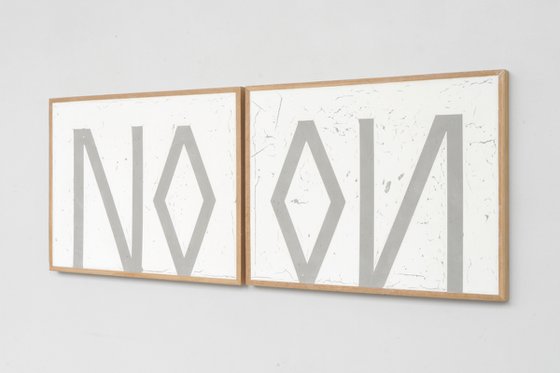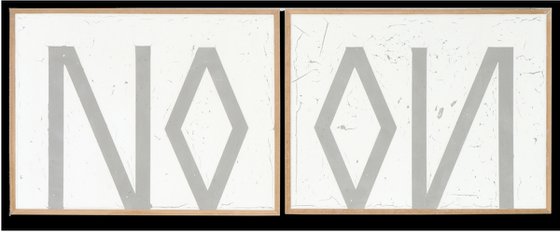- By medium
- By subject
- By budget
- Sales
- Gift cards
- Discover all art
- Artists
- Editors’ picks
- Ideas
Original artwork description:
170x64 cm | Filler, oak frame
Language has a remarkable ability - it can describe the non-existent. It is not, as the material world, bound to what is actually there, it can wander off into new, previously unknown universes, it can invent what didn’t exist before. Things that are entirely new. Matter can create new stuff too, but it always has to follow a strict regime of causality. This is maybe not the case with the use of language. I believe this to be marvellous and not as self-evident it seems at first glance. The non-existent is, in a way even more mysterious than the barred dimension of materiality, the Real, which we never can enter as self-conscious subjects. At least with matter, we know it’s there, though we can never entirely feel and experience the world as matter, bound to language as awareness is. Before we were born and after we die, we habit the void of the non-existent. Which means we don’t exist. We are nothing. Not like emptiness which does exist, but non-existing like no-things. How can we even talk about nothing when it doesn’t exist? The concept of nothing exists, but it has no foundation in the material world. It’s a fantasy, like Santa, ghosts, and everything else we only can imagine.
The mirror displays the material world as an image. An image is transferable; it is language. When we first look in the mirror, we see ourselves as signs, entities of language. This is how we become self-aware. But we know the mirror image is not the same as the actual physical world, and this introduces an unconscious knowledge of a split within the self. Under the surface of our consciousness, beyond language and subjectivity, there is something else. A part of us that is inseparable from the body, connected to matter within and everywhere. This part, the one int the mirror, exists—the other one, the one in our heads - not entirely certain.
Materials used:
Filler (coarse and fine) in oak frame
Tags:
#abstract #painting #minimalism #filler #oak frame#278 Thing (2020) Painting
by Johan Söderström
1 Artist Reviews
£20,536.8
- Painting on Panel / Board / MDF
- One of a kind artwork
- Size: 170 x 64 x 5cm (framed)
- Framed and ready to hang
- Signed on the back
- Style: Graphic, illustrative and typographic
- Subject: Abstract and non-figurative
Loading
Original artwork description
170x64 cm | Filler, oak frame
Language has a remarkable ability - it can describe the non-existent. It is not, as the material world, bound to what is actually there, it can wander off into new, previously unknown universes, it can invent what didn’t exist before. Things that are entirely new. Matter can create new stuff too, but it always has to follow a strict regime of causality. This is maybe not the case with the use of language. I believe this to be marvellous and not as self-evident it seems at first glance. The non-existent is, in a way even more mysterious than the barred dimension of materiality, the Real, which we never can enter as self-conscious subjects. At least with matter, we know it’s there, though we can never entirely feel and experience the world as matter, bound to language as awareness is. Before we were born and after we die, we habit the void of the non-existent. Which means we don’t exist. We are nothing. Not like emptiness which does exist, but non-existing like no-things. How can we even talk about nothing when it doesn’t exist? The concept of nothing exists, but it has no foundation in the material world. It’s a fantasy, like Santa, ghosts, and everything else we only can imagine.
The mirror displays the material world as an image. An image is transferable; it is language. When we first look in the mirror, we see ourselves as signs, entities of language. This is how we become self-aware. But we know the mirror image is not the same as the actual physical world, and this introduces an unconscious knowledge of a split within the self. Under the surface of our consciousness, beyond language and subjectivity, there is something else. A part of us that is inseparable from the body, connected to matter within and everywhere. This part, the one int the mirror, exists—the other one, the one in our heads - not entirely certain.
Materials used:
Filler (coarse and fine) in oak frame
Tags:
#abstract #painting #minimalism #filler #oak frame14 day money back guaranteeLearn more








